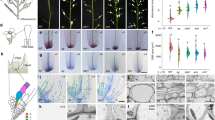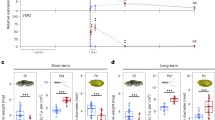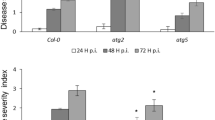Abstract
Jasmonic acid (JA) is an important phytohormone that regulates plant defense responses against herbivore attack, pathogen infection and mechanical wounding. In this report, we provided biochemical and genetic evidence to show that the Arabidopsis thaliana NAC family proteins ANAC019 and ANAC055 might function as transcription activators to regulate JA-induced expression of defense genes. The role of the two NAC genes in JA signaling was examined with the anac019 anac055 double mutant and with transgenic plants overexpressing ANAC019 or ANAC055. The anac019 anac055 double mutant plants showed attenuated JA-induced VEGETATIVE STORAGE PROTEIN1 (VSP1) and LIPOXYGENASE2 (LOX2) expression, whereas transgenic plants overexpressing the two NAC genes showed enhanced JA-induced VSP1 and LOX2 expression. That the JA-induced expression of the two NAC genes depends on the function of COI1 and AtMYC2, together with the finding that overexpression of ANAC019 partially rescued the JA-related phenotype of the atmyc2-2 mutant, has led us to a hypothesis that the two NAC proteins act downstream of AtMYC2 to regulate JA-signaled defense responses. Further evidence to substantiate this idea comes from the observation that the response of the anac019 anac055 double mutant to a necrotrophic fungus showed high similarity to that of the atmyc2-2 mutant.
Similar content being viewed by others
Log in or create a free account to read this content
Gain free access to this article, as well as selected content from this journal and more on nature.com
or
References
Li L, Li C, Lee GI, Howe GA . Distinct roles for jasmonate synthesis and action in the systemic wound response of tomato. Proc Natl Acad Sci USA 2002; 99:6416–6421.
Ryan CA, Moura DS . Systemic wound signaling in plants: a new perception. Proc Natl Acad Sci USA 2002; 99:6519–6520.
Turner JG, Ellis C, Devoto A . The jasmonate signal pathway. Plant Cell 2002; 14(Suppl):S153–S164.
Stratmann JW . Long distance run in the wound response—jasmonic acid is pulling ahead. Trends Plant Sci 2003; 8:247–250.
Howe GA . Jasmonates as signals in the wound response. J Plant Growth Regul 2004; 23:223–237.
Schilmiller AL, Howe GA . Systemic signaling in the wound response. Curr Opin Plant Biol 2005; 8:369–377.
Mason HS, Mullet JE . Expression of two soybean vegetative storage protein genes during development and in response to water deficit, wounding, and jasmonic acid. Plant Cell 1990; 2:569–579.
Hildmann T, Ebneth M, Pena-Cortes H, Sanchez-Serrano JJ, Willmitzer L, Prat S . General roles of abscisic and jasmonic acids in gene activation as a result of mechanical wounding. Plant Cell 1992; 4:1157–1170.
Penninckx IA, Thomma BP, Buchala A, Metraux JP, Broekaert WF . Concomitant activation of jasmonate and ethylene response pathways is required for induction of a plant defensin gene in Arabidopsis. Plant Cell 1998; 10:2103–2113.
Overmyer K, Tuominen H, Kettunen R, et al. Ozone-sensitive arabidopsis rcd1 mutant reveals opposite roles for ethylene and jasmonate signaling pathways in regulating superoxide-dependent cell death. Plant Cell 2000; 12:1849–1862.
Rao MV, Lee H, Creelman RA, Mullet JE, Davis KR . Jasmonic acid signaling modulates ozone-induced hypersensitive cell death. Plant Cell 2000; 12:1633–1646.
Kong HY, Jung HW, Lee SC, Choi D, Hwang BK . A gene encoding stellacyanin is induced in Capsicum annuum by pathogens, methyl jasmonate, abscisic acid, wounding, drought and salt stress. Physiol Plant 2002; 115:550–562.
Feys B, Benedetti CE, Penfold CN, Turner JG . Arabidopsis mutants selected for resistance to the phytotoxin coronatine are male sterile, insensitive to methyl jasmonate, and resistant to a bacterial pathogen. Plant Cell 1994; 6:751–759.
Xie DX, Feys BF, James S, Nieto-Rostro M, Turner JG . COI1: an Arabidopsis gene required for jasmonate-regulated defense and fertility. Science 1998; 280:1091–1094.
Devoto A, Nieto-Rostro M, Xie D, et al. COI1 links jasmonate signalling and fertility to the SCF ubiquitin-ligase complex in Arabidopsis. Plant J 2002; 32:457–466.
Xu L, Liu F, Lechner E, et al. The SCF(COI1) ubiquitin-ligase complexes are required for jasmonate response in Arabidopsis. Plant Cell 2002; 14:1919–1935.
Staswick PE, Su W, Howell SH . Methyl jasmonate inhibition of root growth and induction of a leaf protein are decreased in an Arabidopsis thaliana mutant. Proc Natl Acad Sci USA 1992; 89:6837–6840.
Berger S, Bell E, Mullet JE . Two methyl jasmonate-insensitive mutants show altered expression of AtVsp in response to methyl jasmonate and wounding. Plant Physiol 1996; 111:525–531.
Lorenzo O, Chico JM, Sanchez-Serrano JJ, Solano R . JASMONATE-INSENSITIVE1 encodes a MYC transcription factor essential to discriminate between different jasmonate-regulated defense responses in Arabidopsis. Plant Cell 2004; 16:1938–1950.
Staswick PE, Tiryaki I, Rowe ML . Jasmonate response locus JAR1 and several related Arabidopsis genes encode enzymes of the firefly luciferase superfamily that show activity on jasmonic, salicylic, and indole-3-acetic acids in an assay for adenylation. Plant Cell 2002; 14:1405–1415.
Dombrecht B, Xue GP, Sprague SJ, et al. MYC2 differentially modulates diverse jasmonate-dependent functions in Arabidopsis. Plant Cell 2007; 19:2225–2245.
Chini A, Fonseca S, Fernandez G, et al. The JAZ family of repressors is the missing link in jasmonate signalling. Nature 2007; 448:666–671.
Thines B, Katsir L, Melotto M, et al. JAZ repressor proteins are targets of the SCF(COI1) complex during jasmonate signalling. Nature 2007; 448:661–665.
Anderson JP, Badruzsaufari E, Schenk PM, et al. Antagonistic interaction between abscisic acid and jasmonate-ethylene signaling pathways modulates defense gene expression and disease resistance in Arabidopsis. Plant Cell 2004; 16:3460–3479.
Boter M, Ruiz-Rivero O, Abdeen A, Prat S . Conserved MYC transcription factors play a key role in jasmonate signaling both in tomato and Arabidopsis. Genes Dev 2004; 18:1577–1591.
Bell E, Creelman RA, Mullet JE . A chloroplast lipoxygenase is required for wound-induced jasmonic acid accumulation in Arabidopsis. Proc Natl Acad Sci USA 1995; 92:8675–8679.
Penninckx IA, Eggermont K, Terras FR, et al. Pathogen-induced systemic activation of a plant defensin gene in Arabidopsis follows a salicylic acid-independent pathway. Plant Cell 1996; 8:2309–2323.
Olsen AN, Ernst HA, Leggio LL, Skriver K . NAC transcription factors: structurally distinct, functionally diverse. Trends Plant Sci 2005; 10:79–87.
Souer E, van Houwelingen A, Kloos D, Mol J, Koes R . The no apical meristem gene of Petunia is required for pattern formation in embryos and flowers and is expressed at meristem and primordia boundaries. Cell 1996; 85:159–170.
Aida M, Ishida T, Fukaki H, Fujisawa H, Tasaka M . Genes involved in organ separation in Arabidopsis: an analysis of the cup-shaped cotyledon mutant. Plant Cell 1997; 9:841–857.
Aida M, Ishida T, Tasaka M . Shoot apical meristem and cotyledon formation during Arabidopsis embryogenesis: interaction among the CUP-SHAPED COTYLEDON and SHOOT MERISTEMLESS genes. Development 1999; 126:1563–1570.
Xie Q, Frugis G, Colgan D, Chua NH . Arabidopsis NAC1 transduces auxin signal downstream of TIR1 to promote lateral root development. Genes Dev 2000; 14:3024–3036.
Tran LS, Nakashima K, Sakuma Y, et al. Isolation and functional analysis of Arabidopsis stress-inducible NAC transcription factors that bind to a drought-responsive cis-element in the early responsive to dehydration stress 1 promoter. Plant Cell 2004; 16:2481–2498.
He XJ, Mu RL, Cao WH, Zhang ZG, Zhang JS, Chen SY . AtNAC2, a transcription factor downstream of ethylene and auxin signaling pathways, is involved in salt stress response and lateral root development. Plant J 2005; 44:903–916.
Delessert C, Kazan K, Wilson IW, et al. The transcription factor ATAF2 represses the expression of pathogenesis-related genes in Arabidopsis. Plant J 2005; 43:745–757.
Ooka H, Satoh K, Doi K, et al. Comprehensive analysis of NAC family genes in Oryza sativa and Arabidopsis thaliana. DNA Res 2003; 10:239–247.
Zheng W, Zhai Q, Sun J, et al. Bestatin, an inhibitor of aminopeptidases, provides a chemical genetics approach to dissect jasmonate signaling in Arabidopsis. Plant Physiol 2006; 141:1400–1413.
Utsugi S, Sakamoto W, Murata M, Motoyoshi F . Arabidopsis thaliana vegetative storage protein (VSP) genes: gene organization and tissue-specific expression. Plant Mol Biol 1998; 38:565–576.
Glazebrook J . Contrasting mechanisms of defense against biotrophic and necrotrophic pathogens. Annu Rev Phytopathol 2005; 43:205–227.
Bechtold N, Pelletier G . In planta Agrobacterium-mediated transformation of adult Arabidopsis thaliana plants by vacuum infiltration. Methods Mol Biol 1998; 82:259–266.
Acknowledgements
We are grateful to Dr Xinnian Dong (Duke University, Durham, NC, USA) for critical reading of the manuscript and valuable suggestions. We thank Dr Jianmin Zhou (National Institute of Biological Sciences, Beijing, China) for providing the fungus strain Botrytis cinerea, Dr Salomé Prat (Institut de Biologia Molecular de Barcelona, Barcelona, Spain) for providing homozygous atmyc2-2 (T-DNA insertion line SALK_083483) seeds and Dr Daoxin Xie (Tsinghua University, Beijing, China) for providing the coi1-1 seeds. This work was supported by grants from The National Natural Science Foundation of China (30530440), The Ministry of Science and Technology of China (2006CB102004, 2006AA10A116), and The Chinese Academy of Sciences (KSCX2-YW-N-045).
Author information
Authors and Affiliations
Corresponding author
Supplementary information
Supplementary information Table S2
Oligonucleotide primers used in this study (PDF 36 kb)
Rights and permissions
About this article
Cite this article
Bu, Q., Jiang, H., Li, CB. et al. Role of the Arabidopsis thaliana NAC transcription factors ANAC019 and ANAC055 in regulating jasmonic acid-signaled defense responses. Cell Res 18, 756–767 (2008). https://doi.org/10.1038/cr.2008.53
Received:
Revised:
Accepted:
Published:
Issue date:
DOI: https://doi.org/10.1038/cr.2008.53
Keywords
This article is cited by
-
OsNAC103, an NAC transcription factor negatively regulates plant height in rice
Planta (2024)
-
Genome-wide analyses of the NAC transcription factor family to reveal the potential candidate genes responding to powdery mildew in balsam pear
Plant Biotechnology Reports (2023)
-
Comparative transcriptome analysis of resistant and susceptible wheat in response to Rhizoctonia cerealis
BMC Plant Biology (2022)
-
Gene silencing of SLZF57 reduces drought stress tolerance in tomato
Plant Cell, Tissue and Organ Culture (PCTOC) (2022)
-
The NAC side of the fruit: tuning of fruit development and maturation
BMC Plant Biology (2021)



